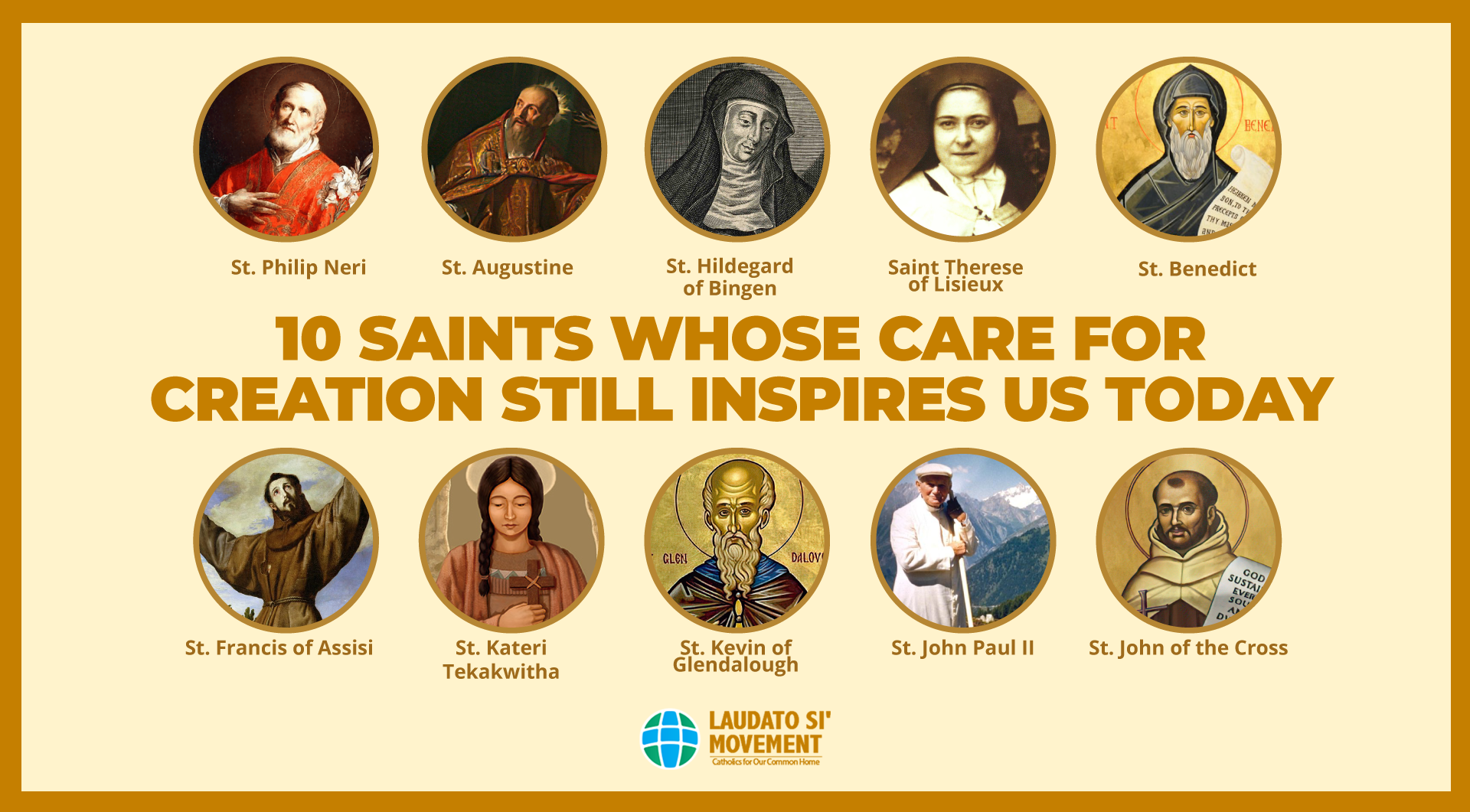
The Catholic Church has made caring for creation a key tenet of the faith for centuries, long before Pope Francis wrote Laudato Si’ and placed that millennia of Catholic teaching in the context of today’s ecological crisis.
As we work to urgently care for God’s creation, may we all find further inspiration from these 10 saints whose passion and love for God’s creation can still motivate us to act today.
1. St. Philip Neri, 1515-1595
St. Philip Neri is best known for his founding of the Oratory Movement, but St. Philip also is remembered and celebrated for his welcoming of vegetarianism.
Neri embraced the diet because of animal welfare. When he was given birds, he would set them free, and he preferred to let flies escape through a window rather than swat them.
His care extended to land-based animals as well. Neri would let captured mice flee to safety and often expressed sympathy for animals being taken to slaughter.
Feast day: 26 May
2. St. Augustine, 354-430
Pop quiz: Is the below quote about “things like mice and fleas that are real but inconvenient” from Laudato Si’ or St. Augustine?
‘‘so strong is this preference, that, had we the power, we would abolish [them] from nature altogether, whether in ignorance of the place they hold in nature, or, though we know it, sacrificing them to our own convenience.’”
Such warnings against self-centeredness in regards to nature show yet again how the Catholic Church has long been about caring for all of God’s creation.
Arthur O. Ledoux, a philosophy professor and lecturer at the Augustinian Study and Legacy at Merrimack College in the U.S., wrote about St. Augustine’s deep love for creation in “A Green Augustine: On Learning to Love Nature Well.”
“For Augustine the ideal would be to see nature as God sees it, feeling deeply both its beauty and its impermanence, loving nature without clinging to it,” Ledoux wrote.
“With such clear seeing would come love and the motivation for sustained and skillful action.”
Feast day: 28 August
3. St. Hildegard of Bingen, 1098-1179
Kings and queens and bishops and popes sought St. Hildegard’s counsel. But the Benedectine nun was perhaps most knowledgeable about admiring and appreciating every creature.
Among her most inspirational words:
- “The Earth sustains humanity. It must not be injured; it must not be destroyed.”
- “Every creature is a glittering, glistening mirror of divinity.”
- “Creation is the song of God.”
- “Humankind is called to co-create, so that we might cultivate the earthly, and thereby create the heavenly.”
“In Hildegard’s worldview, a beam of sunlight, the fragrance of a flower, or the graceful movement of a swan were all participants in the holy chorus of creation,” wrote Cynthia Overweg in a story titled, “Hildegard of Bingen: The Nun Who Loved the Earth.”
Feast day: 17 September
4. St. Therese of Lisieux, 1873-1897
Although she was only 24 when she died, St. Therese left behind a stacks of writings, instructions almost, on how to admire and be in awe of creation.
The below quotes are from the Society of the Little Flower, an organization dedicated to spreading devotion to St. Therese.
“Far away on the horizon we could see the great mountains . . . The sight of these beauties made a deep impression on my thoughts; I felt as if I were already beginning to understand the greatness of God and the wonders of heaven.
“The sun’s light that plays on the cedar trees, plays on each tiny flower as if it were the only one in existence; and in the same way our Lord takes a special interest in each soul.”
Feast day: 1 October
5. St. Benedict, 480-547
St. Benedict, the father of Western monasticism, has seen his love for creation spread throughout the world since his death more than 1,400 years ago.
One of the vows for Benedictines is “stabilitas,” the idea that one should be grounded in a community and place and establish a relationship of care and connection to that place.
Father Abbot John Klassen, OSB, writes, “As Benedictine monastics we want to be people who ‘stay in a place long enough that the spirits can influence us.’ By coming to know a place deeply . . . monastic communities will make decisions with an understanding of their consequences.”
Feast day: 11 July
6. St. Francis of Assisi, 1181-1226
Where to begin with St. Francis of Assisi, the patron saint of ecology? Perhaps Pope Francis describes his Spirit-filled time on Earth best:
“He was a mystic and a pilgrim who lived in simplicity and in wonderful harmony with God, with others, with nature and with himself. He shows us just how inseparable the bond is between concern for nature, justice for the poor, commitment to society, and interior peace.” (LS 10)
Feast day: 4 October, the final day of the Season of Creation
7. St. Kateri Tekakwitha, 1656-1679
St. Kateri Tekakwitha was 20 before she was baptized, yet her life lights the way for all those who seek to live in greater communion with creation.
In July 1677, Tekakwitha was being treated as an outcast in her community and receiving threats because of her faith. So she traveled for two months and more than 200 miles of woods and rivers to the Catholic mission of St. Francis of Xavier at Sault Saint-Louis in Canada.
There, Tekakwitha lived with other Indigenous Catholics and continued devoting her life to God. Her legacy is honored today by many organizations, including the Saint Kateri Conservation Center, which helps organizations and families convert their plots of land or yards into healthy habitats that honor the life of the patron saint of Native American and First Nations People, ecology, and the environment.
Read more: St. Kateri Center celebrates Laudato Si’
Feast day: 14 July
8. St. Kevin of Glendalough, 498 (reputedly) -618
“It is a return to that simplicity which allows us to stop and appreciate the small things, to be grateful for the opportunities which life affords us. . .” (LS 222)
St. Kevin was the model of simplicity. He lived in a cave about 30 feet above the water, according to the Glendalough Hermitage Centre. He ate little and slept on stones.
He also became friends with all creatures, much like St. Francis of Assisi would do 700 years later.
Feast day: 3 July
9. St. John Paul II, 1920-2005
St. John Paul II compelled Catholics to care for creation and to undergo an “ecological conversion” throughout his 27-year papacy. For him, it was personal. He often made time for creation, hiking and skiing in his native Poland and elsewhere.
Speaking in 2001, he said: “If we scan the regions of our planet, we immediately see that humanity has disappointed God’s expectations. Man, especially in our time, has without hesitation devastated wooded plains and valleys, polluted waters, disfigured the earth’s habitat, made the air unbreathable . . .
“We must therefore encourage and support the ‘ecological conversion’ which in recent decades has made humanity more sensitive to the catastrophe to which it has been heading.”
Feast day: 22 October
10. St. John of the Cross, 1542-1591
So meaningful were the life, actions, and writings of St. John of the Cross that Pope Francis dedicated a section of Laudato Si’ to the Spaniard:
“Standing awestruck before a mountain, he or she cannot separate this experience from God, and perceives that the interior awe being lived has to be entrusted to the Lord: ‘Mountains have heights and they are plentiful, vast, beautiful, graceful, bright and fragrant. These mountains are what my Beloved is to me. Lonely valleys are quiet, pleasant, cool, shady and flowing with fresh water; in the variety of their groves and in the sweet song of the birds, they afford abundant recreation and delight to the senses, and in their solitude and silence, they refresh us and give rest. These valleys are what my Beloved is to me.’”






Somewhere in my past …..……I thought I heard that one of the Saints was shown “The Moment of Creation “ ……as Almighty 🙏🏼G❤️🔥D🙏🏼 OPENED UP HIS HAND AND THE BIG BANG OCCURRED ( so to speak) ………do you know anything about this….. trying to find out who that Saint was ???
We love you and care for you! fine fellow
Why isn’t St Martin de Porres on this list??